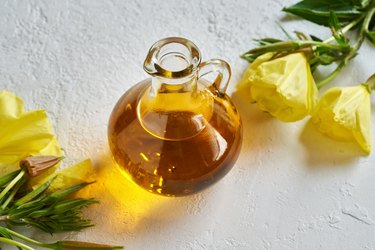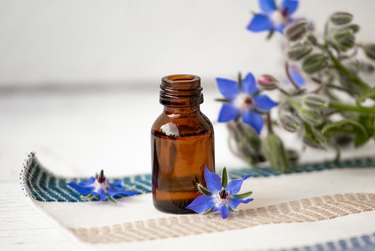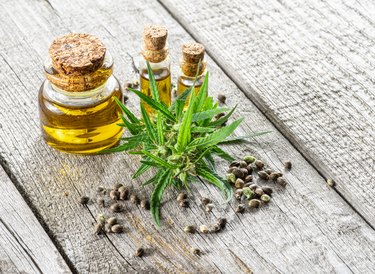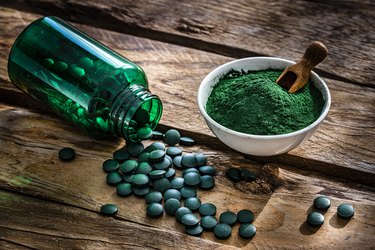Gamma-linolenic acid, or GLA, is an essential omega-6 fatty acid and is often referred to as one of the "good" omega-6s, as it has anti-inflammatory properties.
Like omega-3 fatty acids, omega-6 fats are essential, which means your body cannot make them on its own, so you have to get them through food (think: salmon, fish oil, walnuts and flax seeds). The other omega-6 fatty acids include linoleic acid, arachidonic acid, and dihomo-gamma-linolenic acid (DGLA).
Video of the Day
Video of the Day
Omega-6 fatty acids are thought of as a source of inflammation when out of balance with omega-3s, but that's not the case for GLA. Since the 1980s, research has shown some benefit of GLA and DGLA for inflammatory conditions such as rheumatoid arthritis and skin conditions, per an April 2016 manuscript in the European Journal of Pharmacology.
Inflammatory skin disorders like psoriasis, eczema and atopic dermatitis could benefit from supplementation with GLA, per the Linus Pauling Institute at Oregon State University. The gamma-linolenic acid benefits for skin health are likely related to its ability to convert to anti-inflammatory DGLA within the skin.
GLA is found in human milk, some botanical seed oils and most often taken as a supplement, per the April 2016 European Journal of Pharmacology report. While a typical American diet, or even a vegetarian or vegan diet, won't contain a significant amount of this particular omega-6 fat, there are a few food sources of GLA you can get.
1. Evening Primrose Oil

Evening primrose oil comes from the seeds of the Oenothera biennis, or evening primrose plant, and is a great source of gamma-linolenic acid. It's often used in supplement form and not typically as a food source.
Evening primrose oil isn't approved for the treatment of any disease, but people may find relief from premenstrual syndrome (PMS), hot flashes, gestational diabetes and cervical ripening by using this supplement, per an August 2019 analysis of research in the Journal of Menopausal Women.
2. Borage Oil

Borage oil is the richest source of GLA, containing 18 to 26 percent gamma-linolenic acid, per the University of Rochester Medical Center. Borage oil is most often sold as a supplement rather than a food.
Borage oil contains amabiline, which is a pyrrolizidine alkaloid that is toxic to your liver. The more borage oil you take, the greater the risk of liver damage from this substance, per the Memorial Sloan Kettering Cancer Center. Look for borage oil certified free of unsaturated pyrrolizidine alkaloids to reduce your risk.
3. Hemp Oil

Hemp oil can have 0.5 to 6 percent GLA, per the Oklahoma State University Extension, and the amount can depend on where the seeds are grown. When grown in more extreme climates, like the cold north or warm tropical regions, the percentage of GLA will be higher than hemp that's been harvested from a moderate temperature region.
Unlike evening primrose oil and borage oil, hemp oil is used as a food — not just a supplement.
The high polyunsaturated fat content of hemp oil makes it a poor choice for use when cooking with heat, which can increase the chance that the fatty acids oxidize and form harmful trans fats, per the American Oil Chemists' Society. Leave the sauteeing to other oils and enjoy the benefits of hemp oil in your salad dressing or drizzle it over grains and cooked veggies for flavor.
4. Spirulina

Also known as blue-green algae, spirulina is eaten in other parts of the world but is usually taken as a supplement or added to food in powdered form in the United States. Spirulina has several health benefits including its high GLA content. Ten to 20 percent of the fats in spirulina are gamma-linolenic acid, per a February 2017 review in the Journal of Applied Biotechnology Reports.
You can mix spirulina powder or flakes into water and drink it that way, but if the taste isn't your cup of tea, try adding it to a smoothie or whisking it into a salad dressing.
Blue-green algae harvested from its natural environment has a higher chance of being contaminated with heavy metals, liver toxins and harmful bacteria, per the U.S. National Library of Medicine. To avoid any harmful effects of spirulina, choose a brand that has been tested for contaminants
- European Journal of Pharmacology: "Gamma-linolenic acid, Dihommo-gamma linolenic, Eicosanoids and Inflammatory Processes"
- Oregon State University: " Essential Fatty Acids and Skin Health"
- Journal of Menopausal Women: "Evening Primrose (Oenothera biennis) Oil in Management of Female Ailments"
- Memorial Sloan Kettering Cancer Center:"Borage"
- University of Rochester Medical Center: "Borage Oil"
- Oklahoma State University Extension: "Hemp Seed Oil"
- American Oil Chemists; Society:"Hemp Seed Oil in a Nutshell"
- Journal of Biotechnology Reports: "Spirulina: A Source of Gamma-linoleic Acid and Its Applications "
- National Library of Medicine: "Blue-green Algae"